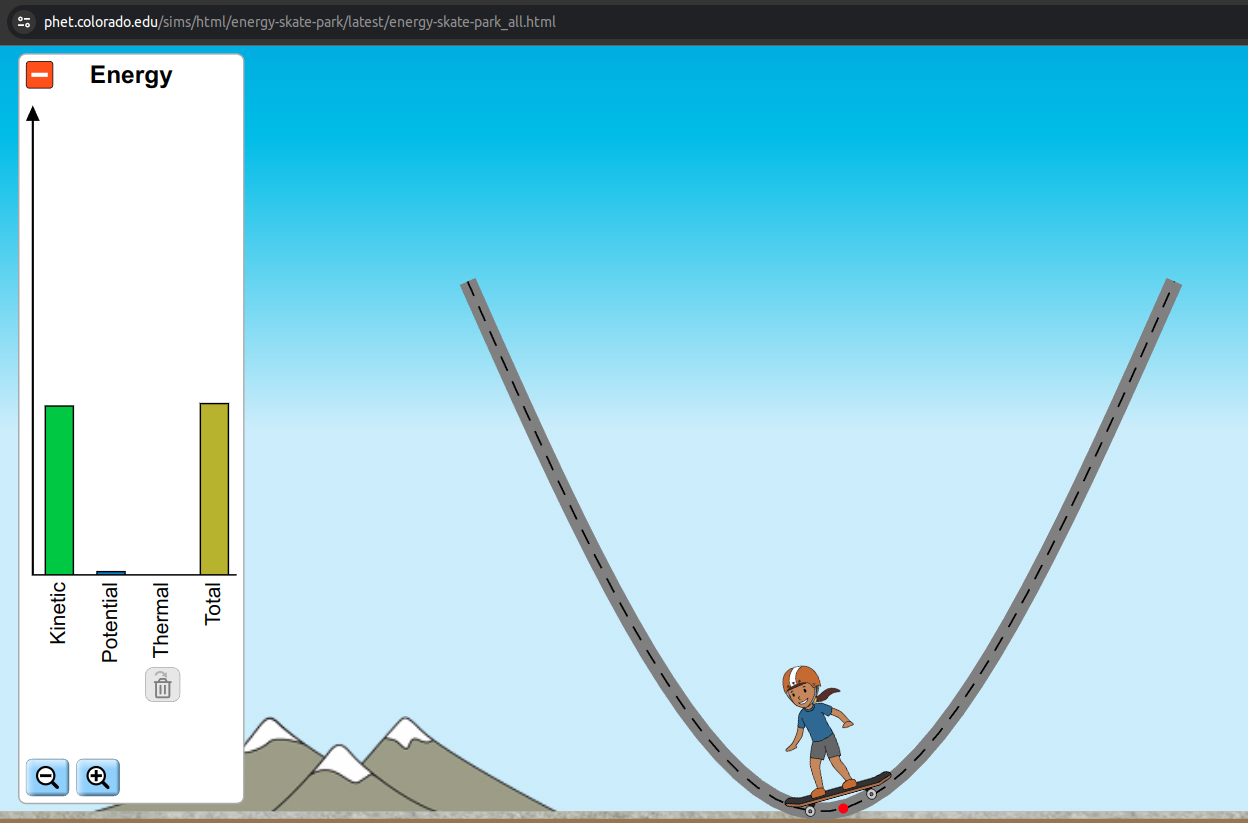6. Energy
Overview
Slides
- 6.1 Work and Energy
- 6.2 Kinetic Energy and Work
- 6.3 Gravitational Potential Energy
- 6.4 Conservation of Energy
- 6.5 Pendulums, Ramps, Efficiency
Skills and Understanding
- Determine work done by a force on an object.
- Determine work as the change in kinetic energy.
- Calculate potential energy.
- Apply conservation laws to determine the transfer of energy.
Equations
\[ \begin{array}{cc} W = F d \cos(\theta) \quad \quad \quad \quad E_{k}=\frac{1}{2}mv^{2} \\ \sum W = \Delta E_{k} \quad \quad \quad \quad E_{p} = mgh \\ \end{array} \]Vocabulary
- Energy is the ability to do work.
- Gravitational Potential Energy is the potential energy of an object at a certain height due to gravity, \(E_{p}= mgh\) where \(h\) is the height of the object.
- Kinetic Energy is the energy of motion, \(E_{k}= \frac{1}{2}mv^{2}\)
- Work is the mechanical transfer of energy. Work by a force on an object is calculated as the product of the component of that force in the direction of motion and the distance moved by that object, \(W=F d \cos(\theta) \) where \(\theta\) is the angle between the applied force and the direction of motion.
- Work-Energy Theorem states that the sum of work on an object is equal to the change in kinetic energy, \(\sum W = \Delta E_{k}\)
6.1 Work
Work is a measure of the transfer of energy that occurs when an applied force results in the displacment of an object. \[W = F d \cos(\theta) \] where \(\theta\) is the angle between the force \(F\) and the direction of motion of the object.
6.2 Kinetic Energy and Work
Kinetic energy is the energy an object possesses in the form of its motion. \[ E_{k} = \frac{1}{2}mv^{2} \] Work can be calculated by finding the change in kinetic energy, \[ W = \Delta E_{k} \]
6.3 Gravitational Potential Energy
The potential energy of an object (due to gravity) is a measure of energy an object has in its potential to fall. The higher up an object is, or the more massive it is, then the more gravitational potential energy it has. \[ E_{p} = mgh \]
6.4 Conservation
Mechanical energy \(E_{M}\) is the total sum of kinetic and potential energy, \[ E_{M} = E_{p} + E_{k} \] When no energy is lost to friction, sound, etc., the mechanical energy remains constant, even as potential and kinetic energies trade off.
Visit the PhET energy skate park. Let the skater loose on the track and click the green + to see the energy graph. Notice that the total energy remains constant, the potential energy is maximized when the skater is higher off the ground, and the kinetic energy is maximized when the skater is going fastest at the bottom of the ramp.

 1. Simple Motion
1. Simple Motion 2. Accelerated Motion
2. Accelerated Motion 3. Projectile Motion
3. Projectile Motion 4. Newton's Laws
4. Newton's Laws 5. Momentum
5. Momentum 6. Energy
6. Energy 7. Heat
7. Heat 8. Electrostatics
8. Electrostatics 9. Circuits
9. Circuits 10. Magnetism
10. Magnetism 11. Waves
11. Waves